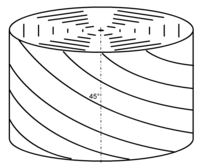Blue phase mode LCD
A blue phase mode LCD is a
History

In
For almost 100 years, scientists assumed that the most stable cholesteric helical structure could be described by a single helical axis about which the director rotates. It turned out that in the new structure the director rotates in a helical fashion about any axis perpendicular to a line as illustrated in fig. 1. Although an unlimited number of helical axes are actually present, this structure was named double twist structure.

This double twist structure is more stable than the single twist structure (i.e., the normal helical structure of

Blue phases are special cases when double twist structures fill up large volumes. When double twist structures are limited in all directions to the distance from the center line where the twist amounts to 45° a double twist cylinder results. Because of its small radius, such a cylinder is more stable than the same volume filled with a single twist chiral nematic liquid crystal.

A large structure can be composed from these double twist cylinders, but defects occur at the points where the cylinders are in contact as illustrated in fig. 5.[3] These defects occur at regular distances and tend to make the structure less stable, but it is still slightly more stable than the single twist structure without defects, at least within a temperature range of about 1 K below the transition from the chiral nematic phase to an isotropic liquid.
The


Wide temperature range blue phases
In 2005, researchers from the Centre of Molecular Materials for Photonics and Electronics at the University of Cambridge reported their discovery of a class of blue-phase liquid crystals that remain stable over a range of temperatures as wide as 16-60 °C.[5] The researchers showed that their ultrastable blue phases could be used to switch the color of the reflected light by applying an electric field to the material, and that this could eventually be used to produce three-color (red, green, and blue) pixels for full-color displays.[6] The new blue phases are made from molecules in which two stiff, rod-like segments are linked by a flexible chain, and are believed to be stabilized due to flexoelectricity.[7]
Furthermore, electro-optical switching with response times of the order of 10−4 s for the stabilized blue phases at room temperature has been shown.[8]
Blue Phase crystals are regarded as 3D photonic crystals, as they possess a periodic cubic structure in the nanometer range with a selective bandgap in the visible wavelengths. However, standard blue phase crystal manufacturing produces polycrystalline samples, the single crystal size being in the micrometer range. Recently, blue phases obtained as ideal 3D photonic crystals in large volumes have been stabilized with a controlled crystal lattice orientation.[9]
Electro-optical switching from monocrystalline blue phases show increased modulation and less scattering than in polycrystalline samples [10]
First blue phase LC-display
In May, 2008 Samsung Electronics announced that it has developed the world's first Blue Phase LCD panel which can be operated at an unprecedented refresh rate of 240 Hz. Samsung unveiled a 15 inch prototype model of its Blue Phase LCD panel at the SID (Society for Information Display) 2008 international Symposium, Seminar and Exhibition, which was held in Los Angeles from May 18 to 23, 2008.[11]
Developed with a look at cost-efficiency, Samsung's Blue Phase mode does not require liquid crystal alignment layers, unlike today's most widely used
In a blue phase based LC-display for TV applications it is not the selective reflection of light according to the lattice pitch (
For a detailed discussion of the blue phase LCs in
See also
References
- S2CID 136035580.
- ^ Timothy J. Sluckin, David A. Dunmur, Horst Stegemeyer: Crystals That Flow - Classic Papers from the History of Liquid Crystals, Liquid Crystals Series, Taylor & Francis
London 2004, ISBN 0-415-25789-1
- ISBN 0-387-98679-0.
- ^ Peter J. Collings, Liquid Crystals - Natures Delicate Phase of Matter, Adam Hilger, Bristol, 1990
- S2CID 4307675.
- S2CID 4432184.
- S2CID 4665796.
- S2CID 31419926.
- PMID 32576875.
- PMID 28281691.
- ^ Samsung Develops World's First 'Blue Phase' Technology to Achieve 240 Hz Driving Speed for High-Speed Video (access date 23 April 2009)
- S2CID 62135317.
- ISSN 0003-6951. Archived from the originalon 2012-07-13. Retrieved 2019-12-05.
- S2CID 2643470.
- S2CID 120451019. Archived from the originalon 2013-07-03. Retrieved 2019-12-05.
- ISSN 0003-6951.
Further reading
- O.D. Lavrentovich, M. Kleman: Defects and Topology of Cholesteric Liquid Crystals" in "Chirality in Liquid Crystals, 5", Springer Verlag: New York (2001), excerpt available here.
See page 124, Figure 5.4 for details on the disclination formed in the gusset (i.e., triangular area where three double twist cylinders are in contact).
